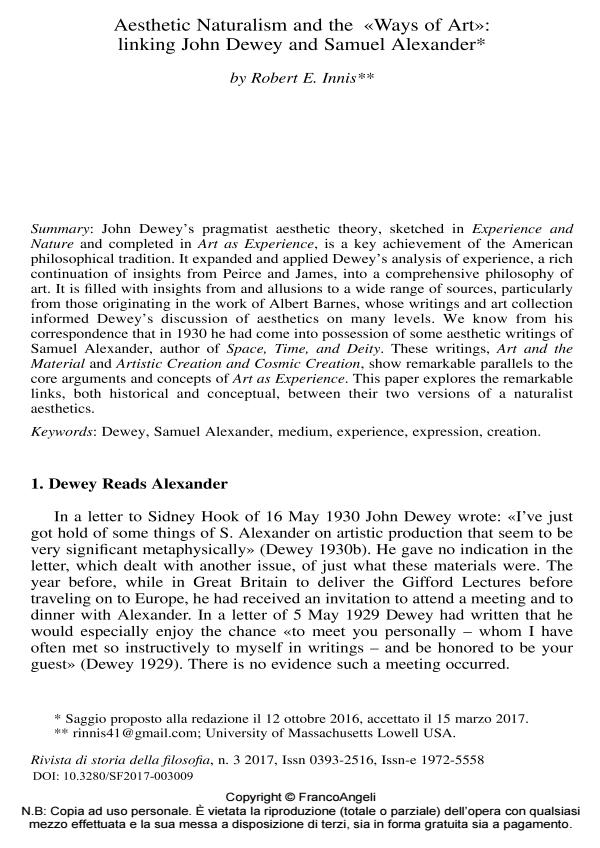Aesthetic Naturalism and the «Ways of Art»: linking John Dewey and Samuel Alexander
Journal title RIVISTA DI STORIA DELLA FILOSOFIA
Author/s Robert E. Innis
Publishing Year 2017 Issue 2017/3
Language English Pages 20 P. 513-532 File size 21251 KB
DOI 10.3280/SF2017-003009
DOI is like a bar code for intellectual property: to have more infomation
click here
Below, you can see the article first page
If you want to buy this article in PDF format, you can do it, following the instructions to buy download credits

FrancoAngeli is member of Publishers International Linking Association, Inc (PILA), a not-for-profit association which run the CrossRef service enabling links to and from online scholarly content.
John Dewey’s pragmatist aesthetic theory, sketched in Experience and Nature and completed in Art as Experience, is a key achievement of the American philosophical tradition. It expanded and applied Dewey’s analysis of experience, a rich continuation of insights from Peirce and James, into a comprehensive philosophy of art. It is filled with insights from and allusions to a wide range of sources, particularly from those originating in the work of Albert Barnes, whose writings and art collection informed Dewey’s discussion of aesthetics on many levels. We know from his correspondence that in 1930 he had come into possession of some aesthetic writings of Samuel Alexander, author of Space, Time, and Deity. These writings, Art and the Material and Artistic Creation and Cosmic Creation, show remarkable parallels to the core arguments and concepts of Art as Experience. This paper explores the remarkable links, both historical and conceptual, between their two versions of a naturalist aesthetics.
Keywords: Dewey, Samuel Alexander, medium, experience, expression, creation.
- Alexander 1891: Samuel Alexander, Moral Order and Progress: An Analysis of Ethical Conceptions, Kegan Paul, Trench, Trübner, and Co., London 1891.
- Alexander 1920: Id., Space, Time, Deity, 2 vols., Macmillan, London 1920.
- Alexander 1933: Id., Beauty and Other Forms of Value, Macmillan, London 1933; reprinted Thoemmes Press, Bristol (UK) 2000.
- Alexander 1939: Id., Philosophical and Literary Pieces, Macmillan, London, 1939; reprinted Greenwood Press, Westport (CT) 1970.
- Dewey AE: John Dewey, Art as Experience, Abraham Kaplan (ed.), Southern Illinois University Press, Carbondale (IL) 1989.
- Dewey EN: Id., Experience and Nature, Southern Illinois University Press, Carbondale (IL) 1988.
- Dewey 1929: Id., Letter to Samuel Alexander 1929.05.31, in Alexander Papers, ALEX/A/1/1/78, John Rylands Univ. Library, Manchester, 1929.
- Dewey 1930a: Id., Letter to Corinne Chisholm Frost 1930.05.15, in John Dewey papers, Frost Correspondence, Number 09274, Special Collections, Morris Library, Southern Illinois University, 1930.
- Dewey 1930b: Id., Letter to Sidney Hook 1930.05.16, In Sidney Hook/John Dewey Collection 1/3, Number: 05732, Morris Library, Southern Illinois University at Carbondale, 1930.
- Innis 1992: Robert E. Innis, Consciousness and the Play of Signs, Indiana University Press, Bloomington (IN) 1992.
- Innis 2009: Id., Susanne Langer in Focus: The Symbolic Mind, Indiana University Press, Bloomington (IN) 2009.
- Innis 2011: Id., The “Quality” of Philosophy: On the Aesthetic Matrix of Dewey’s Pragmatism, in Larry A. Hickman, Matthew Caleb Flamm, Krzysztof Skowro´nski, Jennifer A. Rea (eds.), The Continuing Relevance of John Dewey: Reflections on Aesthetics, Morality, Science, and Society, Rodopi, Amsterdam-New York 2011.
- Innis 2012: Id., The Reach of the Aesthetic and Religious Naturalism: Peircean and Polanyian Reflections, «Tradition and discovery», 38 (2012), 3, pp. 31-50.
- Innis 2016: Id., Dewey’s Peircean Aesthetics, «Cuadernos de Sistemática Peirceana», 6 (2016).
- Muirhead, Mackanzie, Alexander, Ritchie 1894: John H. Muirhead, John. S. Mackanzie, Samuel Alexander, David G. Ritchie, The Meaning of “Motive”, «The International Journal of Ethics», vol. 4, (Jan., 1894), 2, pp. 229-238.
- Seel 2005: Martin Seel, Aesthetics of Appearing, trans. John Farrell, Stanford University Press, Stanford (CA) 2005.
- Art as Occupations: Two Neglected Roots of John Dewey's Aesthetics Fabio Campeotto, Juan Manuel Saharrea, Claudio Marcelo Viale, in The Pluralist /2023 pp.1
DOI: 10.5406/19446489.18.2.01
Robert E. Innis, Aesthetic Naturalism and the «Ways of Art»: linking John Dewey and Samuel Alexander in "RIVISTA DI STORIA DELLA FILOSOFIA" 3/2017, pp 513-532, DOI: 10.3280/SF2017-003009